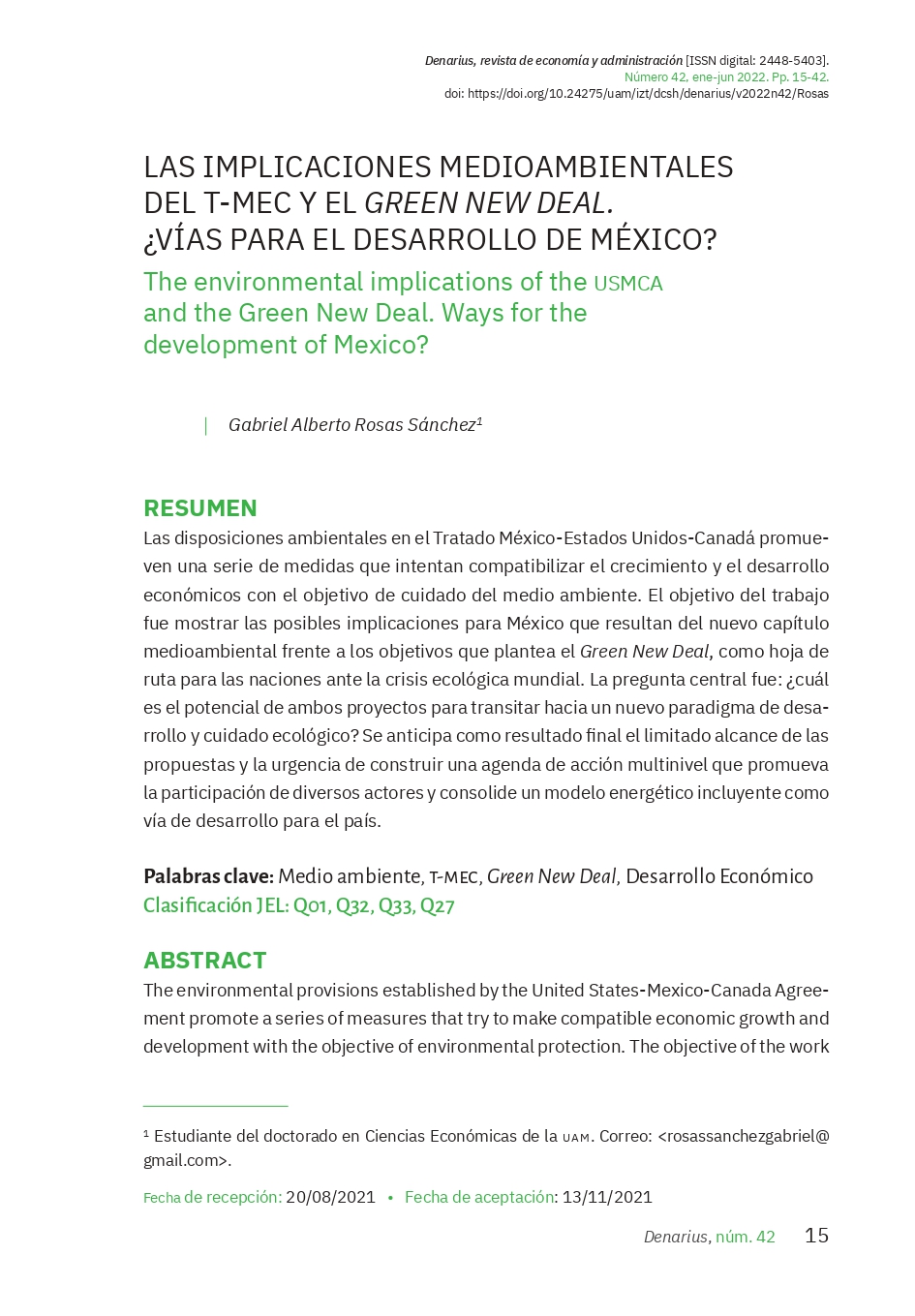Las Implicaciones Medioambientales del T-MEC y el Green New Deal. ¿Vías Para el Desarrollo de México?
Resumen
Las disposiciones ambientales en el Tratado México-Estados Unidos-Canadá promueven una serie de medidas que intentan compatibilizar el crecimiento y el desarrollo económicos con el objetivo de cuidado del medio ambiente. El objetivo del trabajo fue mostrar las posibles implicaciones para México que resultan del nuevo capítulo medioambiental frente a los objetivos que plantea el Green New Deal, como hoja de ruta para las naciones ante la crisis ecológica mundial. La pregunta central fue: ¿cuál es el potencial de ambos proyectos para transitar hacia un nuevo paradigma de desarrollo y cuidado ecológico? Se anticipa como resultado final el limitado alcance de las propuestas y la urgencia de construir una agenda de acción multinivel que promueva la participación de diversos actores y consolide un modelo energético incluyente como vía de desarrollo para el país.
Descargas
Citas
Barbier, E. (2010). A Global Green New Deal: Rethinking the Economic Recovery. Cambridge University Press.
Barkin, D. (2012). Hacia un nuevo paradigma social. Polis. Revista Latinoamericana, (33).
Bernal, D. (2013). El acceso a recursos genéticos en pueblos indígenas y el Convenio de Diversidad Biológica. Civilizar Ciencias Sociales y Humanas, 13(24).
Bilgili, F., Koçak, E. y Bulut, Ü. (2016). The Dynamic Impact of Renewable Energy Consumption on CO2 Emissions: a Revisited Environmental Kuznets Curve approach. Renewable and Sustainable Energy Reviews, (54).
Castaingts, J. (2015). Dinero, trabajo y poder. Una visión de la economía actual latinoamericana para no economistas y economistas. Anthropos.
CEPAL (2020). La emergencia del cambio climático en América Latina y el Caribe: ¿seguimos esperando la catástrofe o pasamos a la acción?
Crutzen, P. y Stoermer, E. (2000). The Anthropocene. Royal Swedish Academy of Sciences, Stockholm, (41).
Dinda, S. (2004). Environmental Kuznets Curve Hypothesis: a Survey. Ecological Economics, 49(4).
Feidt, M. (2009). Efficacité Energétique: Quels Critères. Termotechnica, (2).
Galvin, R. y Healy, N. (2020). The Green New Deal in the United States: What it is and how to pay for it. Energy Research and Social Science, 67.
Georgescu-Roegen, N. (1971). The Entropy law and the Economic Process. Cambridge Press.
Georgescu-Roegen, N. (1979). La Décroissance: Entropie, Ecologie, Economie. Paris: Éditions Sang de la Terre.
International Energy Agency (2020). Data and Statistiques.
Jeannot, F. (2018). El capitalismo emocional del populismo. Contribuciones a la Economía, julio-septiembre, Servicios Académicos Intercontinentales SL.
Jeannot, F. (2020). La competitividad imperfecta en el umbral del coronavirus. Contribuciones a la Economía, abril-junio, Servicios Académicos Intercontinentales SL.
Kirchherr, J., Reike, D. y Hekkert, M. (2017). Conceptualizing the Circular Economy: An Analysis of 114 Definitions. Resources, Conservation and Recycling, 127.
Mikayilov, J., Hasanov, F. y Galeotti, M. (2018). Decoupling of CO2 Emissions and gdp: a Time-Varying Cointegration Approach. Ecological Indicators, 95.
Moshiri, S. y Duah, N. (2016). Changes in Energy Intensity in Canada. The Energy Journal, 37(4).
Munir, Q., Lean, H. y Smyth, R. (2020). CO2 Emissions, Energy Consumption and Economic Growth in the asean-5 Countries: a cross-Sectional Dependence Approach. Energy Economics, 85.
Nadal, A. y Aguayo, F. (2020). Los motores de la degradación ambiental: el modelo macroeconómico y la explotación de los recursos naturales en América Latina. CEPAL.
Nadal, A. (2015). Macroeconomic Policies and Environmental Sustainability. En J. Martínez-Alier y R. Muradian (eds.). Handbook of Ecological Economics. Edward Elgar Publishing.
Nogués, F. (2010). Energía de la biomasa. Universidad de Zaragoza.
Rolston iii, H. (1982). Are Values in Nature Subjective or Objective? Environmental Ethics, 4.
Sinn, H. (2012). The Green Paradox: a Supply-Side Approach to Global Warming. MIT press.
Smil, V. (2019). Energy in World History. Routledge. Sundaram, J. (2013). A Global Green New Deal for Sustainable Development. Economic and Political Weekly, 48.
United Nations Statistics Division (2020). Environmental Data.
Urpelainen, J. y Van de Graaf, T. (2018). United States Non-cooperation and the Paris Agreement. Climate Policy, 18(7).
Programa de Naciones Unidas para el Medio Ambiente (2018). Proposed Medium- term Strategy for the Period 2014-2017.
Rifkin, J. (2019). The Green New Deal: Why the Fossil Fuel Civilization Will Collapse by 2028, and the Bold Economic Plan to Save Life on Earth. St. Martin’s Press.
Secretaría de Economía (2020). Un acercamiento a las disposiciones del nuevo tratado entre México, Estados Unidos y Canadá.
Stern, D. (2007). The Effect of nafta on Energy and Environmental Efficiency in Mexico. Policy Studies Journal, 35(2).
Stephenson, J., Barton, B., Carrington, G., Gnoth, D., Lawson, R. y Thorsnes, P. (2010). Energy Cultures: a Framework for Understanding Energy Behaviors. Energy Policy, 38(10).
Wang, K. y Wei, Y. (2014). China’s Regional Industrial Energy Efficiency and Carbon Emissions Abatement Costs. Applied Energy, 130.
World Bank (2020). World Development Indicators.

Derechos de autor 2022 Denarius

Esta obra está bajo licencia internacional Creative Commons Reconocimiento-NoComercial-CompartirIgual 4.0.













